Planning a road trip across Southeast Asia is an exciting adventure! You'll need to research visa requirements and local driving regulations for each country. Popular destinations include Chiang Mai for its culture, Luang Prabang for its heritage, and beautiful beaches like Koh Rong. Budget wisely for fuel, accommodations, and meals. Embrace spontaneity and be open to unexpected stops along the way. Stick around, and you'll discover more tips to make your journey unforgettable!
Key Takeaways
- Research visa requirements and ensure your passport is valid for at least six months beyond your departure date for each country visited.
- Choose a suitable rental vehicle and familiarize yourself with local driving regulations, especially since Thailand drives on the left side.
- Budget for fuel, accommodation, and transportation, considering costs for buses, sleeper trains, or domestic flights as you plan your route.
- Explore key destinations like Chiang Mai, Luang Prabang, and Angkor Wat, incorporating cultural experiences and natural attractions into your itinerary.
- Embrace spontaneity by using navigation apps to discover hidden gems and be flexible with plans to seize unexpected opportunities.
Planning Your Southeast Asia Road Trip

When you're planning your Southeast Asia road trip, what should you prioritize first? Start by researching the visa requirements for each country on your itinerary. Regulations vary, with some nations offering visa-on-arrival and others requiring e-visas.
Next, familiarize yourself with local driving regulations and road conditions, as poorly maintained roads can pose challenges. Choose a suitable rental vehicle—like a motorcycle for narrow paths or a van for family trips—and guarantee you've secured adequate insurance coverage.
Use mapping tools like Google Maps to plan your route, estimate travel times, and identify interesting stops.
Finally, budget for fuel, accommodation, and tolls, keeping in mind that fuel prices typically range from $1 to $1.50 USD per liter across the region.
Choosing the Best Destinations

After you've sorted out the logistics of your road trip, it's time to think about where to go.
For a well-rounded Southeast Asia itinerary, start in Chiang Mai, where stunning landscapes and rich cultural experiences await.
Head over to Luang Prabang in Laos, known for its UNESCO World Heritage-listed temples and the breathtaking Kuang Si Waterfalls.
Don't forget Cambodia's Angkor Wat, a must-see for history buffs, showcasing incredible architecture and ancient Khmer civilization.
If you're seeking relaxation, explore Koh Rong, famous for its beautiful beaches, or the pristine shores of the Perhentian Islands in Malaysia.
Each destination offers unique adventures, ensuring your road trip is filled with unforgettable moments and breathtaking locations.
Essential Travel Documents and Visas
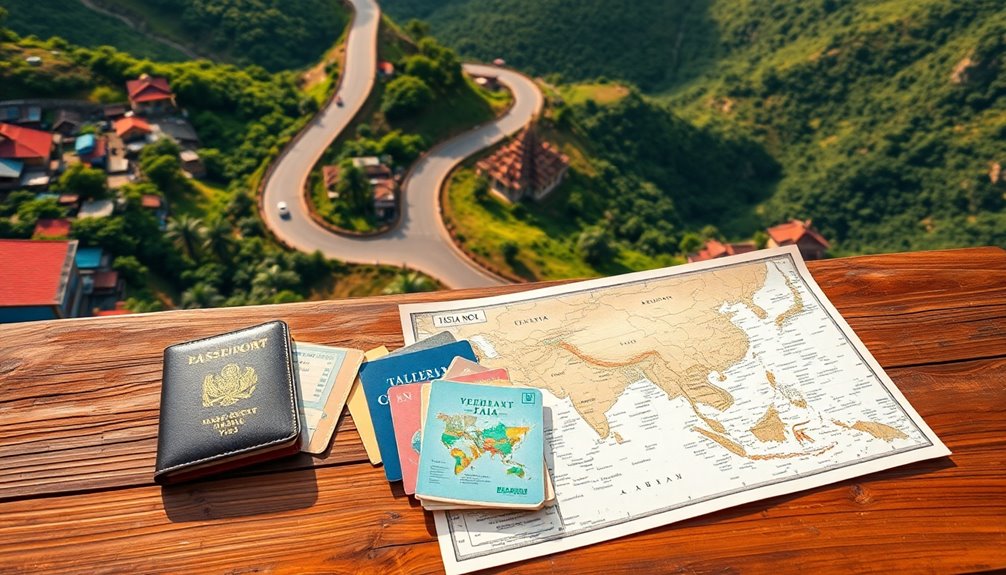
Before hitting the road in Southeast Asia, you need to sort out your travel documents and visas.
Make sure your passport's valid for at least six months beyond your departure date, and check the visa regulations for each country on your itinerary.
Being prepared will save you time and hassle at border crossings.
Required Travel Documents
Traveling across Southeast Asia can be an exhilarating experience, but having the right travel documents is essential. Most countries in South-East Asia offer a visa-upon-arrival option, making spontaneous trips easier for many travelers.
For Vietnam, you'll need a pre-purchased E-Visa, which you can obtain online in about three business days. In Thailand and Cambodia, you can enjoy stays of up to 30 days without a visa, while Laos may have shorter durations depending on your nationality.
Always check specific immigration policies and entry requirements based on your nationality, as restrictions can apply. Plus, guarantee your passport is valid for at least six months beyond your planned departure date to avoid any entry issues.
Visa Regulations Overview
Understanding visa regulations is key to a smooth journey through Southeast Asia. Each country has its own rules, often based on your nationality. Be sure to research the visa requirements for your specific situation before heading out.
| Southeast Asian Country | Visa Type |
|---|---|
| Thailand | Visa-on-arrival |
| Vietnam | E-Visa (pre-purchased) |
| Indonesia | Visa-free (30 days) |
| Cambodia | Visa-on-arrival |
While many countries offer visa-on-arrival or allow short stays without a visa, others may impose entry restrictions. For example, Israeli passport holders should check specific policies. Always verify your options to guarantee hassle-free border crossings during your travels.
Passport Validity Requirements
How prepared are you for your Southeast Asia adventure? Before you hit the road, make sure your passport is valid for at least six months beyond your entry date. This is vital to avoid any issues with immigration.
Visa requirements vary across countries; for instance, Thailand, Cambodia, and Laos often allow visa-on-arrival for many nationalities, while Vietnam requires a pre-purchased e-visa. It's important to check the specific entry requirements based on your nationality to stay compliant with local immigration policies.
If you plan to extend your stay, remember that extensions for tourist visas are usually available, but be aware of local regulations and associated fees.
Stay informed, and your trip will be smooth sailing!
Navigating Transportation Options
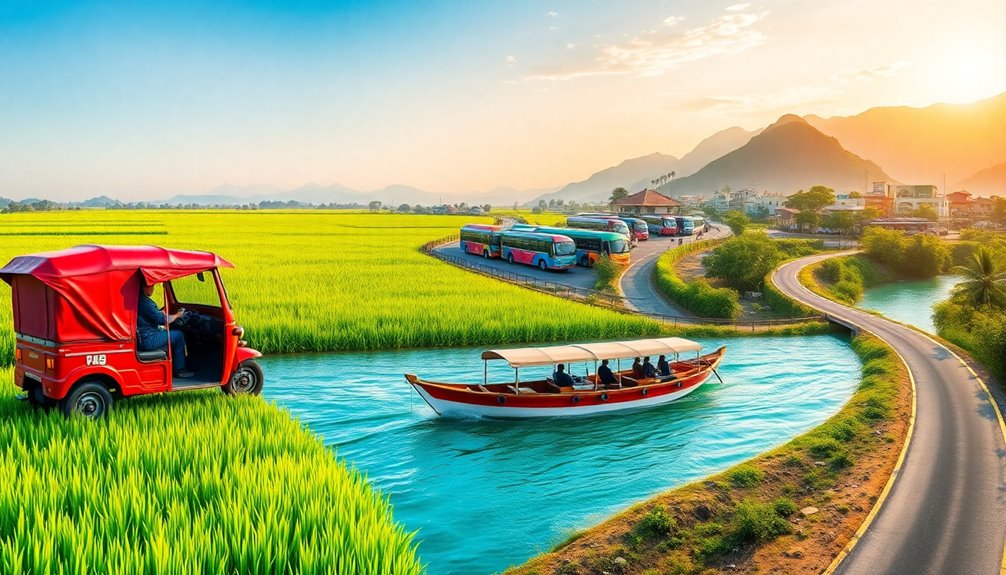
While exploring Southeast Asia, you'll find that maneuvering through transportation options can be both affordable and diverse.
Buses are a popular choice for long journeys, with fares typically ranging from $10-$30 USD.
If you're looking for a unique overnight experience, consider sleeper trains in Thailand and Vietnam, which cost between $20-$50 USD.
For quicker travel, domestic flights through budget airlines like AirAsia often offer affordable tickets under $50 USD when booked in advance.
If you prefer exploring at your own pace, motorbike rentals are common, averaging $5-$10 USD daily—just remember to carry your international driver's license.
Finally, ferries and boats help you reach stunning islands, with prices ranging from $5-$20 USD based on distance and service type.
Tips for Budgeting Your Trip
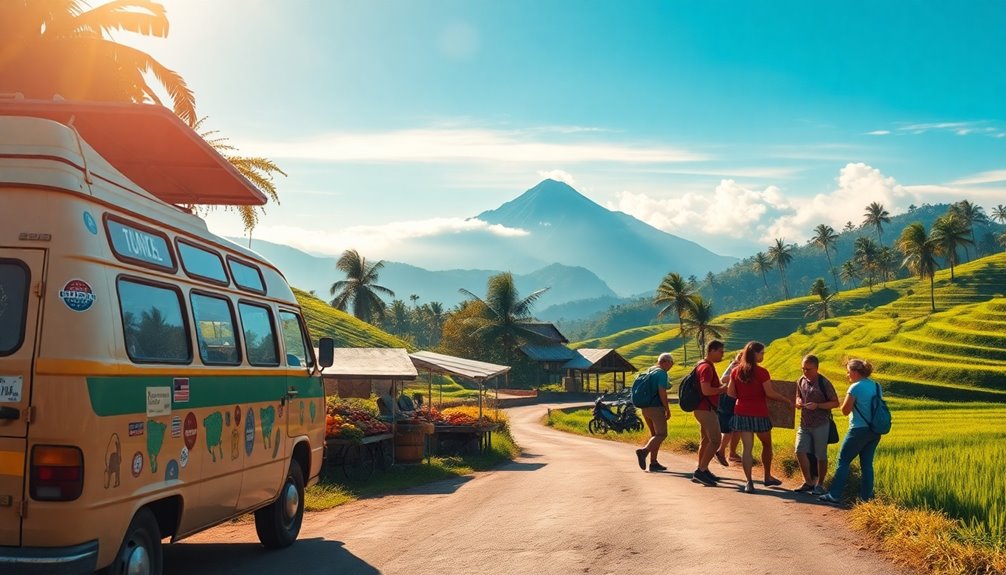
Budgeting your trip across Southeast Asia can be straightforward and rewarding. Set a daily budget of around $20-50 USD for your accommodation, meals, and activities.
You'll find plenty of budget-friendly options like hostels and delicious street food, where meals typically cost just $1-5 USD. Use public transportation, such as buses and sleeper trains, to keep travel costs low—long-distance bus rides range from $10-15 USD.
Explore free or low-cost attractions, like temples and natural parks, to manage expenses effectively. Don't forget to look for discounts on activities; booking in advance or checking with local travel agencies can lead to great deals.
With smart budgeting, you can enjoy all the wonders Southeast Asia has to offer without breaking the bank!
Safety Considerations on the Road

As you plan your road trip across Southeast Asia, safety should be a top priority. Many roads are poorly maintained, especially in rural areas, so drive cautiously and watch for unexpected potholes or unpaved sections. Additionally, make sure your vehicle is in good condition before embarking on your journey to minimize breakdown risks. Familiarize yourself with local driving laws and customs, as they can vary significantly from country to country. By prioritizing safety and exploring essential road routes in Asia, you’ll enhance your travel experience while ensuring a smoother adventure through this diverse region.
Each country has different traffic laws; for example, in Thailand, you'll drive on the left side of the road, and it's essential to stick to local speed limits to avoid fines. Make sure your insurance coverage includes international travel to prevent legal and financial issues in case of accidents.
Familiarize yourself with emergency contacts, as they vary by country—like 191 for police in Thailand and 113 in Vietnam.
Finally, keep an eye out for wildlife and livestock on the roads to avoid potential collisions.
Cultural Etiquette and Local Customs

Understanding cultural etiquette and local customs is essential for a smooth and enjoyable road trip across Southeast Asia.
In Thailand, greet others with a "wai," pressing your palms together and bowing slightly to show respect.
In Laos, avoid touching someone's head, as it's considered sacred.
When visiting temples, dress modestly by covering your shoulders and knees, and remember to remove your shoes to reflect your reverence.
In Vietnam, always use both hands when giving or receiving items, as this indicates appreciation in local culture.
Additionally, in Cambodia, removing your shoes before entering homes and businesses highlights the importance of cleanliness and respect.
Embracing these customs will enhance your travel experience and foster positive connections with locals.
Must-See Attractions Along the Route
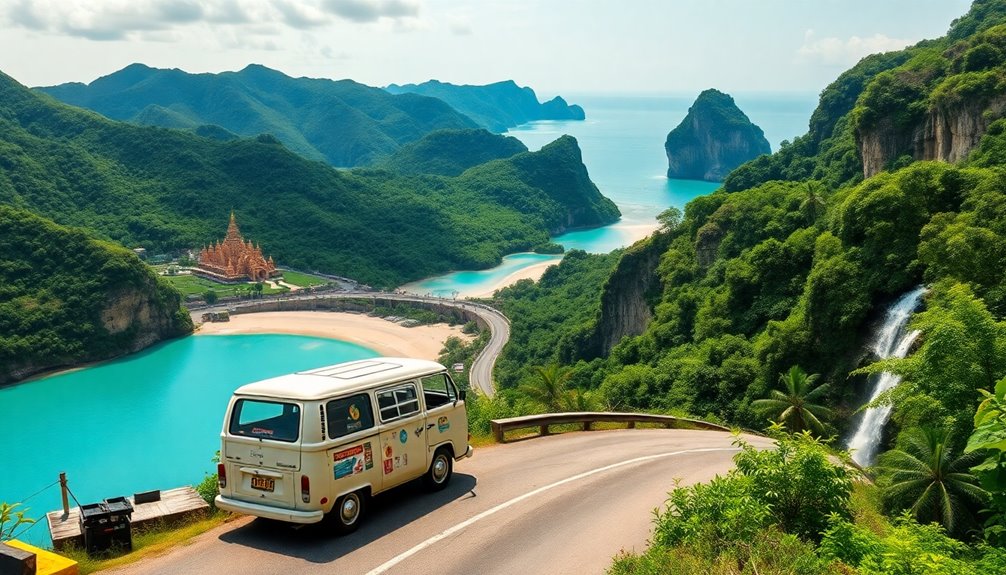
What unforgettable sights await you on your road trip across Southeast Asia?
Start in Bangkok, where vibrant street markets and cultural landmarks set the stage for adventure.
Next, explore the ancient wonders of Angkor Wat, a UNESCO World Heritage Site in Cambodia, showcasing the largest religious monument in the world.
Head north to Chiang Mai, where the historic Old City and famous Night Bazaar offer unique local handicrafts.
Don't miss the serene beauty of Luang Prabang, another UNESCO World Heritage Site, known for Kuang Si Falls and its rich cultural heritage.
Finally, unwind at Railay Beach, with its stunning limestone cliffs and crystal-clear waters, perfect for rock climbing and relaxation.
Each stop promises unforgettable experiences!
Food and Accommodation Recommendations
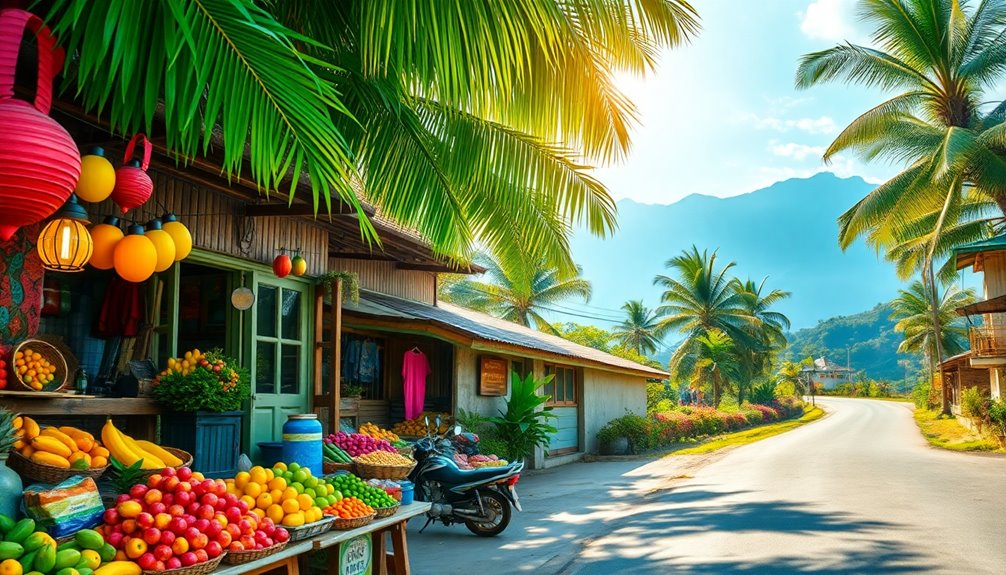
While exploring Southeast Asia, you'll find that the region's food scene is as vibrant as its landscapes, offering a tantalizing array of flavors that reflect its rich cultural tapestry.
Street food is a must-try, with meals typically costing between $1-$5 USD. Don't miss out on delicious dishes like Pad Thai in Thailand or Pho in Vietnam for unique culinary experiences.
For a local experience, head to hawker centers in Singapore, where diverse cuisines await.
When it comes to accommodation, budget-friendly hostels range from $5-$15 USD per night, letting you save while you explore.
If you plan a longer stay, bungalows in places like Pai, Thailand, offer amazing rates at around £30/month, ensuring comfort without breaking the bank.
Embracing Spontaneity and Adventure

When you hit the open road in Southeast Asia, unplanned destinations often lead to the most memorable experiences.
Engaging with locals and embracing a flexible itinerary not only enriches your journey but also encourages unexpected adventures.
You'll find that the true essence of travel lies in the spontaneity and connections you create along the way.
Unplanned Destinations Await
Embracing spontaneity on your Southeast Asia road trip opens the door to unexpected adventures and hidden gems.
With well-maintained roads and affordable car rentals, you can easily explore off-the-beaten-path destinations at your own pace. Use navigation apps like Google Maps to discover spontaneous stops, whether it's a stunning waterfall or a lively local festival.
You'll stumble upon unique roadside markets and breathtaking landscapes that many tourists overlook. This flexibility in travel lets you extend your stay in enchanting locations, like a serene beach in Cambodia or a vibrant town in Laos. Additionally, embracing open communication can enhance your travel experience by ensuring everyone's preferences and desires are voiced and considered.
Local Experiences Enhance Journey
Spontaneity on your road trip not only leads you to hidden gems but also opens the door to enriching local experiences.
You'll stumble upon hidden street food stalls offering mouthwatering meals for just a few dollars, deepening your cultural understanding.
Take scenic detours through rural villages or explore lesser-known national parks, where you'll witness authentic local life firsthand.
Traveling by local transport, like tuk-tuks or sleeper trains, connects you with fellow travelers and the vibrant vendors along the way.
Embrace spontaneous stops at picturesque locations, from serene waterfalls to bustling markets, each moment adding to your collection of unforgettable memories.
Every unplanned adventure enhances your journey and brings you closer to the heart of Southeast Asia.
Flexible Itinerary Benefits Travelers
A flexible itinerary opens up a world of possibilities, allowing you to seize unexpected opportunities that can transform your trip. By embracing spontaneity, you might stumble upon local festivals or events not found in guidebooks, enriching your cultural immersion.
This adaptability lets you extend your stay in picturesque beaches or vibrant cities, ensuring a personalized experience tailored to your interests. You'll have the chance to explore off-the-beaten-path destinations, uncovering stunning natural landscapes like secluded waterfalls and breathtaking viewpoints often overlooked by rigid plans.
Plus, with flexibility, you can easily adjust to weather changes, dodging monsoon rains or taking advantage of unexpected sunny days for outdoor adventures. This approach truly enhances your journey through Southeast Asia.
Frequently Asked Questions
Is $1000 a Month Enough for Southeast Asia?
Yes, $1000 a month can be enough for Southeast Asia if you budget wisely.
You'll find affordable accommodations, with hostels costing $5-15 per night, and meals for just $1-5.
Transportation is also low-cost, with bus rides around $10. Engaging in local activities won't break the bank either.
However, you should keep in mind that this budget limits high-end experiences, so careful planning is essential for a fulfilling trip.
How Much Money Do You Need for 3 Months in Southeast Asia?
You'll need around $1,500 to $2,500 for three months in Southeast Asia.
Daily expenses typically range from $20 to $50, depending on your travel style. Street food is super affordable, costing just $1 to $5, while hostel beds range from $5 to $15.
Don't forget about transportation and entry fees, which can add up, so budgeting for those is essential.
Also, consider visa costs, as they vary by country.
Is 2 Months Enough for Southeast Asia?
Two months in Southeast Asia can feel like a thrilling sprint through a vibrant festival.
You'll definitely have enough time to visit highlights like Thailand, Vietnam, and Cambodia while soaking up local cultures.
Aim to prioritize must-see spots to avoid feeling rushed.
Flexibility is key; stay open to spontaneous adventures and deeper dives into areas that capture your heart.
Embrace the journey, and you'll create unforgettable memories along the way!
Conclusion
As you hit the road across Southeast Asia, remember that spontaneity is often the key to unforgettable adventures. Did you know that over 40% of travelers in this region say they discover their favorite experiences through unplanned detours? Embrace the unexpected, connect with locals, and savor the diverse cultures along the way. With the right planning and an open mind, you're sure to create memories that'll last a lifetime. Buckle up and enjoy the journey!









